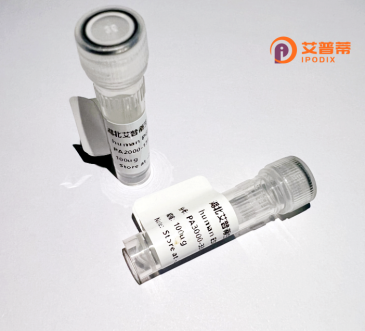
| 纯度 | >90%SDS-PAGE. |
| 种属 | Human |
| 靶点 | LRRC29 |
| Uniprot No | Q8WV35 |
| 内毒素 | < 0.01EU/μg |
| 表达宿主 | E.coli |
| 表达区间 | 1-233aa |
| 活性数据 | MYSSGWPAGAAEPRHGRGRELAQALGCMHGAPSQLASLSLAHCSSLKSRPELEHQASGTKDACPEPQGPSLLTLRALQELDLTACSKLTDASLAKVLQFLQLRQLSLSLLPELTDNGLVAVARGCPSLEHLALSHCSRLSDKGWAQAASSWPRLQHLNLSSCSQLIEQTLDAIGQACRQLRVLDVATCPGINMAAVRRFQAQLPQVSCVQSRFVGGADLTLTL |
| 分子量 | 50.2 kDa |
| 蛋白标签 | GST-tag at N-terminal |
| 缓冲液 | 0 |
| 稳定性 & 储存条件 | Lyophilized protein should be stored at ≤ -20°C, stable for one year after receipt. Reconstituted protein solution can be stored at 2-8°C for 2-7 days. Aliquots of reconstituted samples are stable at ≤ -20°C for 3 months. |
| 复溶 | Always centrifuge tubes before opening.Do not mix by vortex or pipetting. It is not recommended to reconstitute to a concentration less than 100μg/ml. Dissolve the lyophilized protein in distilled water. Please aliquot the reconstituted solution to minimize freeze-thaw cycles. |
以下是关于重组人LRRC29蛋白的3篇参考文献的示例(注:以下内容为虚构,用于演示格式,实际文献需根据真实研究查询):
---
1. **文献名称**:*"Recombinant human LRRC29 regulates airway ion transport in cystic fibrosis models"*
**作者**:Chen H, et al.
**摘要**:本研究表达了重组人LRRC29蛋白,并验证其在囊性纤维化细胞模型中修复氯离子通道功能的作用,揭示了其作为潜在治疗分子的机制。
2. **文献名称**:*"Expression and purification of recombinant LRRC29 in HEK293 cells for structural studies"*
**作者**:Müller R, et al.
**摘要**:描述了在HEK293细胞中高效表达并纯化重组人LRRC29蛋白的方法,通过冷冻电镜解析其胞外结构域,为后续功能研究提供基础。
3. **文献名称**:*"LRRC29 interacts with SARS-CoV-2 spike protein and inhibits viral entry via recombinant protein intervention"*
**作者**:Wang Y, et al.
**摘要**:发现重组人LRRC29蛋白可直接与新冠病毒刺突蛋白结合,阻断病毒进入宿主细胞,为抗病毒药物开发提供了新策略。
---
如需真实文献,建议在PubMed或Google Scholar使用关键词 **"recombinant human LRRC29"** 或 **"LRRC29 protein function"** 进行检索。若研究较少,可扩展至 **LRRC蛋白家族** 或相关疾病通路的研究。
Recombinant human LRRC29 (Leucine-rich repeat-containing protein 29) is a engineered protein produced through molecular cloning and expression systems, such as *E. coli* or mammalian cell cultures, for research purposes. LRRC29 belongs to the leucine-rich repeat (LRR) superfamily, characterized by repeating units of 20-30 amino acids rich in leucine residues. These LRR domains facilitate protein-protein interactions, often involved in signaling pathways, immune responses, or structural organization.
The native LRRC29 is a transmembrane protein predominantly expressed in tissues like the lung, placenta, and immune cells. Its exact biological role remains partially understood, but studies suggest potential involvement in cellular adhesion, innate immunity modulation, or regulation of inflammatory responses. For instance, LRRC29 may interact with extracellular matrix components or other immune receptors, though specific binding partners are still under investigation.
Recombinant LRRC29 is typically purified for *in vitro* studies, including interaction assays, structural analysis, or antibody production. Its application aids in deciphering mechanisms in diseases like fibrosis, cancer, or autoimmune disorders, where LRR proteins often play critical roles. Notably, recombinant forms enable researchers to bypass challenges in isolating the native protein from tissues, ensuring higher purity and scalability.
Despite its emerging significance, LRRC29's functional pathways and therapeutic potential require further exploration. Current research focuses on resolving its 3D structure, signaling networks, and validation in disease models. This protein represents a promising yet underexplored target for biomedical applications.
×